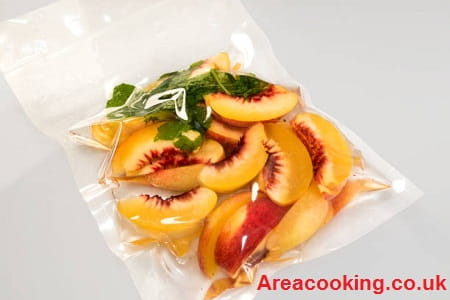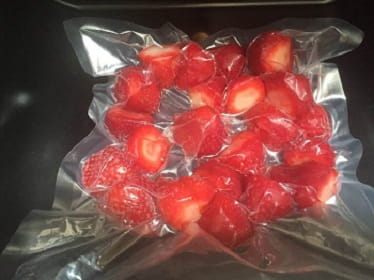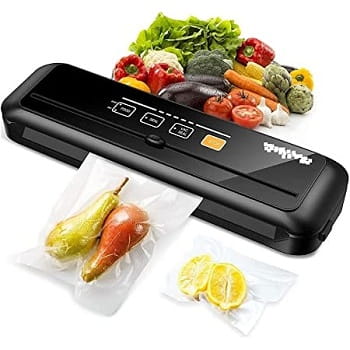As an Amazon Associate, I earn from qualifying purchases.

If you want to keep your fruits fresh for a longer period of time, vacuum sealing is the way to go. It removes the air from the bag, which prevents bacteria from growing and keeps the fruit from rotting. Here’s a guide on how to vacuum seal your fruit.
Why Vacuum Seal Fruits?
Before we dive into the process of vacuum sealing fruits, it is essential to understand why it is beneficial. Vacuum sealing is a method of removing the air from the packaging of food items, leaving them in a vacuum-sealed bag. Here are some reasons why vacuum sealing fruits is a great idea:
- Increased Shelf Life: Vacuum-sealed fruits can last up to three times longer than those stored in conventional methods.
- Preservation of Nutritional Value: Vacuum sealing helps to preserve the nutrients in fruits by slowing down the process of oxidation.
- Maintains Freshness: By removing the air, vacuum sealing ensures that the fruits maintain their freshness, flavor, and color.
- Reduces Waste: With vacuum sealing, you can buy fruits in bulk and store them for a more extended period, reducing food waste.
What You Will Need
Before you begin vacuum sealing your fruits, you will need to gather the necessary equipment. Here is a list of things you will need:
- A vacuum sealer machine
- Vacuum sealer bags or rolls
- Fruits of your choice
- A knife and cutting board
- Marker pen
- Optional: Fruit preservative or lemon juice
Contents
Steps to Vacuum Seal Fruits
Now that you have your equipment ready let us dive into the steps of vacuum sealing your fruits:
Step 1: Prepare Your Fruits
Wash your fruits under running water to remove dirt and debris. Dry them with a clean cloth or paper towel. Slice your fruits into your desired size.
Step 2: Pre-Freeze Your Fruits
Before vacuum sealing your fruits, it is essential to pre-freeze them for better results. Lay the sliced fruits in a single layer on a baking sheet and freeze them for an hour or until they are frozen. This step will prevent the fruits from getting crushed during the vacuum sealing process.
Step 3: Label the Vacuum Sealer Bags
Use a marker pen to label your vacuum sealer bags with the type of fruit, date of packaging, and any additional information you may find necessary.
Step 4: Vacuum Seal Your Fruits
Place the frozen fruits into the vacuum sealer bags, leaving enough space for the vacuum sealer to create a tight seal. If you are using a fruit preservative, add it at this point. Place the open end of the bag into the vacuum sealer and let the machine do its job. Once the air is removed, the machine will seal the bag automatically.
Step 5: Store the Vacuum-Sealed Fruits
Store the vacuum-sealed fruits in the refrigerator or freezer, depending on the fruits’ requirements. Some fruits like berries, grapes, and cherries can be stored in the refrigerator, while others like apples and citrus fruits require the freezer.
The Benefits Of Vacuum Sealing Fruit

Vacuum sealing fruit is an effective way to extend its shelf life and prevent spoilage. By removing the air from around the fruit, vacuum sealing prevents mold and bacteria from growing and causing the fruit to rot. Vacuum sealing also prevents the fruit from drying out, so it stays fresh and juicy for longer.
There are many benefits to vacuum sealing fruit, but one of the most important is that it helps to preserve the nutritional value of the fruit. When fruit is exposed to air, it begins to lose its vitamins and minerals. By vacuum sealing the fruit, you can help to keep it fresh and nutritious for longer.
Vacuum sealing fruit is also a great way to save money. By extending the shelf life of the fruit, you can avoid having to buy fresh fruit as often. This can be a great way to save money on your grocery bill.
If you are looking for a way to keep your fruit fresh and delicious for longer, vacuum sealing is a great option.
Tip How To Vacuum Seal Fruit

Here are some additional tips to keep in mind when vacuum sealing fruits:
- Avoid overfilling the vacuum sealer bags to ensure a tight seal.
- To prevent fruit browning, use a fruit preservative or add lemon juice to the fruits before sealing.
- Do not vacuum seal fruits that have mold or fungus growth.
- Use high-quality vacuum sealer bags or rolls to ensure that your fruits remain fresh for a more extended period.
What Type Of Vacuum Sealer To Use For Fruit?

Vacuum sealing is a great way to preserve fruits for a longer period of time. There are different types of vacuum sealers available in the market, so it is important to choose the right one for your needs. If you are looking for a vacuum sealer to use for fruit, then you should consider getting a handheld vacuum sealer. Handheld vacuum sealers are small and lightweight, making them easy to use and store. They are also less expensive than other types of vacuum sealers.
FAQs
Can you vacuum seal any type of fruit?
Yes, you can vacuum seal any type of fruit that you want to preserve.
Can I vacuum seal fresh fruits without freezing them?
It is best to pre-freeze your fruits before vacuum sealing them for better results.
How long do vacuum-sealed fruits last?
Vacuum-sealed fruits can last up to three times longer than those stored in conventional methods.
Can I vacuum seal fruits with sugar or syrup?
Yes, you can vacuum seal fruits with sugar or syrup, but it is essential to ensure that they are evenly distributed to prevent clumping.
Can vacuum sealing fruits affect their taste or texture?
Vacuum sealing fruits helps to maintain their taste and texture, and even enhances their flavor by preserving their freshness.
Conclusion
Now that you know how to vacuum seal fruits, you can keep them fresh for longer periods of time. This is a great way to prevent fruits from spoiling, and it can help you save money on groceries. Be sure to use the correct techniques to vacuum seal fruits, and you’ll be able to enjoy them for longer periods of time.





